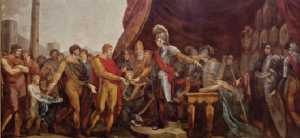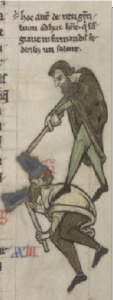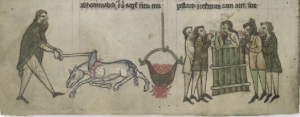THE REMONSTRANCE OF IRISH PRINCES, 1317
Published in Features, Issue 6 (November/December 2013), Medieval History (pre-1500), Volume 21
Above: Long after Gerald of Wales, the claim that Irish rulers freely submitted to Henry II was included in proclamations of the English right to rule Ireland. In the late 1780s, Vincenzo Waldré produced this painting of the Irish princes’ submission for the ceiling of St Patrick’s Hall in Dublin Castle, accompanied by other paintings depicting English rule as a civilising and Christianising mission. (National Monuments Service)
The English crown first intervened in Ireland in 1171. King Henry II came to curb the power of his Anglo-Norman subjects, who were seizing Irish territories for themselves; Diarmait MacMurchada had brought them here in the late 1160s to help him regain the kingship of Leinster. Henry also wished to impose his authority on the Irish, and many kings and church leaders acknowledged his overlordship. Gerald of Wales (c. 1146–1223) is our chief source for these events. In the Topography of Ireland (1188) and Conquest of Ireland (1189), Gerald argues that the English crown has the right to rule Ireland because of five legitimate claims and a mission to civilise a barbarous people. His writings shaped English and European views of Ireland for centuries.
Laudabiliter
The fifth element of England’s ‘fivefold right’ to Ireland refers to the English Pope Adrian IV’s decree, Laudabiliter, granting Ireland to Henry II in the mid-1150s. Adrian’s right to make this grant depended on the Donation of Constantine (exposed as a forgery in the fifteenth century), which stated that Constantine, the first Christian Roman emperor, granted the West, including its outlying islands, to the papacy. Laudabiliter represents Ireland as barbaric and effectively pagan. It grants Ireland to Henry so that he can ‘reveal the truth of the Christian faith to unlearned and savage peoples, and root out from the Lord’s field the weeds of vice that grow in it’.

Henry II of England in Gerald’s Conquest of Ireland, who says he possessed ‘a familiarity with pretty well the whole outline of history, which he could readily draw on’. (NLI)
Gerald develops Laudabiliter’s theme of semi-pagan Irish savagery in the Topography of Ireland: ‘This is a filthy people, wallowing in vice . . . the least instructed in the rudiments of the Faith . . . above all other peoples they always practise treachery’. Gerald is careful to discredit Irish kings. They did not achieve kingship ‘by right of anointing or even of heredity or order of succession, but only by force and arms’. An Ulster king was inaugurated after ritual sexual intercourse with a horse, which he then ate. The Irish are a gens silvestris (a woodland people) who ‘live on beasts only and live like beasts. They have not progressed at all from the primitive habits of pastoral living.’ Gerald, like other medieval ethnographers, presents human progress as a movement from pastoralism to settled agriculture and ultimately city life. A civilised person, a civis (citizen), lives in a civitas (an association of citizens—a city). The idle woodland Irish reject agriculture, cities, ‘the rights and privileges of citizenship’ and hence civilisation itself. Gerald thus depicts the conquest as justified not only by the ‘fivefold right’ but also by the mission to civilise and truly Christianise the Irish that underlies the fifth claim.
English claims rejected

Above: In Topography, Gerald claims the Irish always carry an axe because it’s the perfect weapon for treacherous killers; it doesn’t have to be unsheathed, bent or poised like a sword, bow or spear, but ‘without further preparation, beyond being raised a little, it inflicts a mortal blow’. The Conquest calls for a total ban on Irish axe-ownership. (NLI)
The English claim to Ireland was always contentious. Gerald complained: ‘Now let the envious and thoughtless end their vociferous complaints that the kings of England hold Ireland unlawfully’. The Remonstrance’s rejection of the claim was sent to Pope John XXII by Domhnall Ua Néill of the Cenél nEogáin line of the northern Uí Néill. The Remonstrance describes Domhnall as ‘King of Ulster and by hereditary right the true heir to the whole of Ireland’. Domhnall claims the support of the Irish élite and people, calls for papal backing against English rule and offers the kingship of Ireland to Edward Bruce of Scotland.
The Remonstrance’s timing and link with Scotland are crucial. In 1314, at Bannockburn, Edward Bruce’s brother Robert, the Scottish king, halted Edward II of England’s attempt to conquer Scotland. Earlier, Robert Bruce wrote to the Irish, emphasising their shared ancestry, language and customs (the medieval definition of nationhood) and urging cooperation to ‘regain our nation’s ancient freedom’. Edward Bruce landed in Ireland in 1315 and Domhnall joined his campaign. The Remonstrance echoes Robert’s letter and presents the Scots and Irish as one nation; ‘the kings of Lesser Scotia [Scotland] . . . have all traced their ancestral origin to our Greater Scotia [Ireland], retaining our language and habits to some extent’.
Milesian legend used by both sides
The Remonstrance against the English right to rule Ireland may be influenced by the exchanges in Scotichronicon (sidebar left), which illuminate its historical context and help to explain its arguments. Its begins with Irish origins: ‘. . . the three sons of Milesius . . . of Spain came by God’s will with a fleet of thirty ships from Cantabria, a Spanish city which stands on the banks of the Hiber [Ebro] (from which we have received the name that we have) to Hibernia [Ireland], then devoid of inhabitants’. This account and the Scottish origin-legend in Scotichronicon build on traditions that find their greatest Irish expression in the Lebor Gabála Érenn (the Book of Invasions). The Lebor Gabála traces Gaelic origins from Scythia to Egypt to Spain, whence the sons of Míl (Milesius) reach Ireland.
Gerald of Wales knew the Milesian legend and referred to it in the Topography, where he integrated it with Geoffrey of Monmouth’s account of the ancient British king Gurguint Barbtruc giving Ireland to Basclenses from Spain. Geoffrey writes that Gurguint ‘sent them with guides to Ireland, an island at the time devoid of inhabitants, which he granted to them’. Gerald strengthens Geoffrey’s message that Guirguint owned Ireland; it was ‘either uninhabited or had been settled by him’. Ignoring this account of Irish origins, the Remonstrance thereby rejects the first English claim to Ireland. The Irish came to Ireland ‘by God’s will’ and not that of a British king. The Remonstrance thus invalidates Gerald’s third claim too: the English right to Ireland based on possession of the Basque capital.
Stereotypes of Irish barbarism challenged
The Remonstrance provides an outline of Irish history that challenges the remaining claims and stereotypes of Irish barbarism. It says that the sons of Milesius came from ‘Cantabria, a Spanish city’. This reference to urban origins implies that the ancestors of the Irish were civilised. But English rule is barbarising the Irish: the invaders have ‘forced us to seek mountains, forests, bogs and barren places, even rocky caves, in order to save our lives, and over a long period have made us dwell in these places like wild beasts’. The Remonstrance here links the Irish with persecuted biblical Jews ‘wandering in deserts, in mountains and in dens and in caves of the earth’ (Hebrews 11:38). It evokes the heroic Maccabees, who fought against foreign pagan despotism when living ‘in the mountains and in dens, like wild beasts’ (2 Maccabbees 10:7), a favourite model of the just war in the Age of Crusades. The Irish fight against the English crown and colonists because they are the victims of ‘implacable enmities and perpetual wars’ arising from colonial oppression. Appeals to the English king for justice have gone unanswered.
The Remonstrance rejects the second and fourth English claims: ‘neither we nor our fathers have ever paid homage to [the king] himself or his fathers or taken any other oath of fealty’. The Remonstrance ignores Arthur. It claims that, before Henry, Irish kings ‘vigorously defended the inheritance granted them by God against tyrants and kings of various regions, always retaining intact their native freedom’. The Remonstrance’s vision of pre-conquest Ireland celebrates its unity, stability and Rome-centred Christian orthodoxy (a major theme in Irish historical writings since at least the seventh century). It informs the pope of an orderly succession of kings ‘without admixture of foreign blood’ and ‘excellently instructed in the faith of Christ’. They protected and enriched the church since ‘our chief apostle and patron St Patrick [was sent] in 435 by your predecessor Pope Celestine at the inspiration of the Holy Spirit’. The implications are clear: the Irish were a civilised and Christian people under divine providence and there was no justification for the civilising mission that underpinned the crown’s fifth claim: the authority of Laudabiliter.
‘Crafty foxes and ravening wolves’

Above: The images in Topography emphasise Irish exoticism and barbarism. The inauguration of Ulster kings is illustrated here: following ritual sexual intercourse with a horse, which is then slaughtered, the king bathes in a great pot containing the horse-flesh and eats the meat! (NLI)
The Remonstrance claims that Henry II obtained Laudabiliter by exploiting Pope Adrian’s English sensibilities. It identifies Adrian’s English ‘feeling and nature’ and not his ‘origin’ as the reason he supported Henry: a careful distinction. The Remonstrance shifts Laudabiliter’s date to 1170 and implies that Henry used Ireland to deflect attention from the murder of Thomas Becket, archbishop of Canterbury, for which he was ‘perhaps’ responsible in that year. The Remonstrance emphasises that the invaders wanted to enrich themselves by seizing Irish land, enslaving the people and plundering the churches. This makes Laudabiliter doubly invalid as a claim, since the crown failed to act as a moral force and defender of religion. The conquest was cloaked ‘with a certain outward semblance of holiness and religion’, but the conquerors were ‘crafty foxes and ravening wolves’: a phrase that associates them with Herod (Luke 13:32) and false prophets (Matthew 7:15). These ‘viperous’ oppressors have forced the Irish to adopt ‘a serpent’s cunning’ in order to survive: resonant scriptural language in a land where the absence of snakes symbolised the people’s goodness and innocence.
The Remonstrance reverses Geraldine accusations of Irish bad faith by detailing the colonists’ perfidia, a word that connotes treachery, heresy and unbelief. It distinguishes between the English and the colonists: ‘a middle nation . . . so different from the English of England and any other nation that they can most properly be called a nation not of middling but of extreme perfidia’. The Remonstrance details their betrayal and murder of Irish people and claims that they ‘make the heretical assertion that it is no more a sin to kill an Irishman than a dog or any other brute creature’.
Authority transferred to Edward Bruce
To save the Irish, Domhnall turns to Edward Bruce, descended ‘from our noblest ancestors’. Domhnall’s lineage gives him the right to rule: direct descent from Legarius (Loegaire of Tara), who ruled in Patrick’s time and succeeded kings who ruled since the sons of Milesius. ‘And as each person is free to give up his right’ (Et cum liberum sit unicuique iuri suo renunciare), Domhnall transfers his authority to Edward Bruce. Gerald of Wales used a version of this phrase to bind the Irish to the English crown: because a man is free to give up his right (Item cum iuri suo renunciare liberum sit cuilibet), the Irish kings freely bound themselves to Henry and cannot reverse their submission. The Remonstrance, which denies this ever happened, argues that Henry obtained Ireland fraudulently, broke his promises and initiated Ireland’s sufferings. The heir to Ireland’s rightful kings now appeals to a successor of the pope who legalised ‘this miserable situation’ to recognise the transfer of his usurped royal authority to another king of Milesian blood, ‘so that he may dispense judgement with justice and equity’.
In the event, the pope did not support the Remonstrance’s plea and the Bruce invasion of Ireland failed to overthrow English rule; Edward Bruce was killed in 1318. But the Remonstrance preserves a unique expression of Irish identity. And Gerald, the Remonstrance and Scotichronicon testify to the powerful role of origin-legends and historical narratives in shaping debates about national identity and sovereignty across the medieval archipelago. HI
Diarmuid Scully lectures in history at University College Cork.
READ MORE : England’s ‘fivefold right’ to Ireland
Scotichronicon
Further reading
M. Brown, Disunited kingdoms: peoples and politics in the British Isles 1280–1460 (Harlow, 2013).
R.R. Davies, The first English empire: power and identities in the British Isles 1093–1343 (Oxford, 2000).
S. Duffy, Robert the Bruce’s Irish wars: the invasions of Ireland 1306–29 (Stroud, 2002).
R. Frame, Colonial Ireland 1169–1369 (Dublin, 1981; 2nd edn 2012).
















